Page 44 of 522
WARNING! (Continued)
•Two people should never be belted into a single
seat belt. People belted together can crash into one
another in an accident, hurting one another badly.
Never use a lap/shoulder belt or a lap belt for more
than one person, no matter what their size.
Lap/Shoulder Belt Operating Instructions
1. Enter the vehicle and close the door. Sit back and
adjust the seat.
2. The seat belt latch plate is located on the B-Pillar along
the outboard side and rear of the seat cushion. Grasp the
latch plate and pull out the belt. Slide the latch plate up
the webbing as far as necessary to make the belt go
around your lap.
Latch Plate
2
THINGS TO KNOW BEFORE STARTING YOUR VEHICLE 43
Page 45 of 522
3. When the belt is long enough to fit, insert the latch
plate into the buckle until you hear a “click.”WARNING!
•A belt that is buckled into the wrong buckle will
not protect you properly. The lap portion could ride
too high on your body, possibly causing internal
injuries. Always buckle your belt into the buckle
nearest you.
• A belt that is too loose will not protect you as well.
In a sudden stop, you could move too far forward,
increasing the possibility of injury. Wear your seat
belt snugly.
• A belt that is worn under your arm is very danger-
ous. Your body could strike the inside surfaces of the
vehicle in a collision, increasing head and neck
injury. A belt worn under the arm can cause internal
injuries. Ribs aren’t as strong as shoulder bones.
Wear the belt over your shoulder so that your stron-
gest bones will take the force in a collision.
(Continued)
Latch Plate To Buckle
44 THINGS TO KNOW BEFORE STARTING YOUR VEHICLE
Page 46 of 522
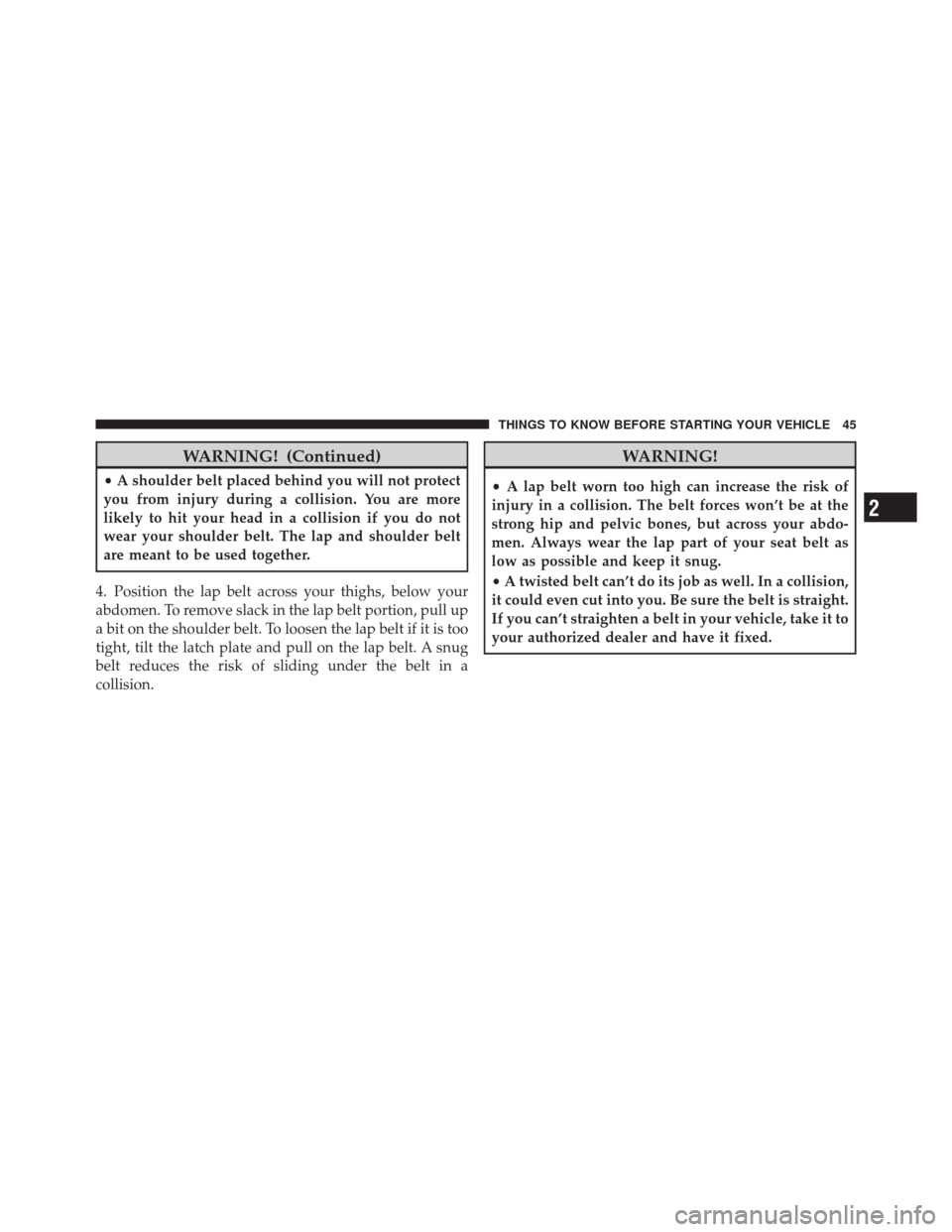
WARNING! (Continued)
•A shoulder belt placed behind you will not protect
you from injury during a collision. You are more
likely to hit your head in a collision if you do not
wear your shoulder belt. The lap and shoulder belt
are meant to be used together.
4. Position the lap belt across your thighs, below your
abdomen. To remove slack in the lap belt portion, pull up
a bit on the shoulder belt. To loosen the lap belt if it is too
tight, tilt the latch plate and pull on the lap belt. A snug
belt reduces the risk of sliding under the belt in a
collision.
WARNING!
• A lap belt worn too high can increase the risk of
injury in a collision. The belt forces won’t be at the
strong hip and pelvic bones, but across your abdo-
men. Always wear the lap part of your seat belt as
low as possible and keep it snug.
• A twisted belt can’t do its job as well. In a collision,
it could even cut into you. Be sure the belt is straight.
If you can’t straighten a belt in your vehicle, take it to
your authorized dealer and have it fixed.
2
THINGS TO KNOW BEFORE STARTING YOUR VEHICLE 45
Page 47 of 522
5. Position the shoulder belt on your chest so that it is
comfortable and not resting on your neck. The retractor
will withdraw any slack in the belt.6. To release the belt, push the red button on the buckle.
The belt will automatically retract to its stowed position.
If necessary, slide the latch plate down the webbing to
allow the belt to retract fully.
WARNING!
A frayed or torn belt could rip apart in a collision and
leave you with no protection. Inspect the belt system
periodically, checking for cuts, frays, or loose parts.
Damaged parts must be replaced immediately. Do
not disassemble or modify the system. Seat belt
assemblies must be replaced after an accident if they
have been damaged (bent retractor, torn webbing,
etc.).
Lap/Shoulder Belt Untwisting Procedure
Use the following procedure to untwist a twisted lap/
shoulder belt.
Removing Slack From Belt
46 THINGS TO KNOW BEFORE STARTING YOUR VEHICLE
Page 54 of 522
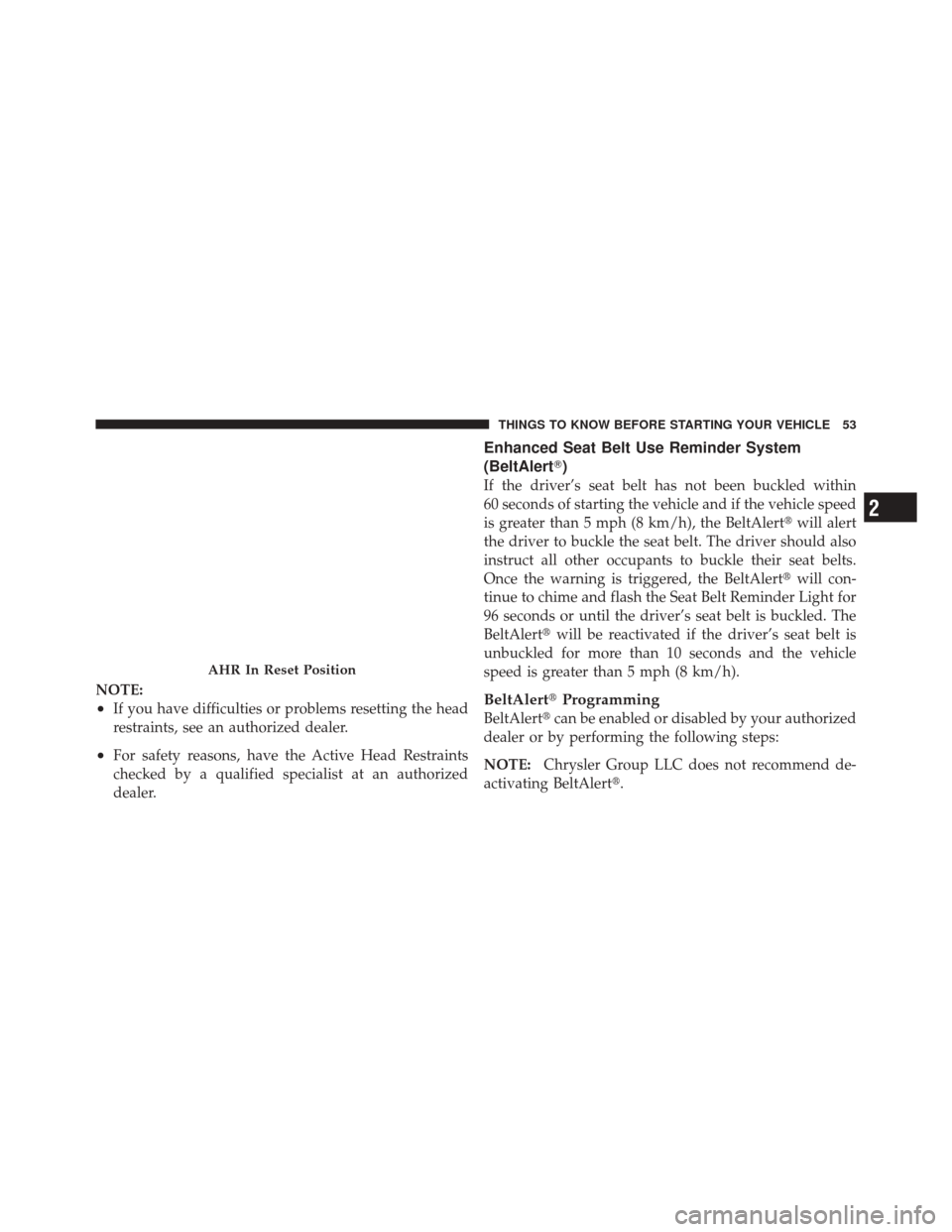
NOTE:
•If you have difficulties or problems resetting the head
restraints, see an authorized dealer.
•For safety reasons, have the Active Head Restraints
checked by a qualified specialist at an authorized
dealer.
Enhanced Seat Belt Use Reminder System
(BeltAlert�)
If the driver’s seat belt has not been buckled within
60 seconds of starting the vehicle and if the vehicle speed
is greater than 5 mph (8 km/h), the BeltAlert�will alert
the driver to buckle the seat belt. The driver should also
instruct all other occupants to buckle their seat belts.
Once the warning is triggered, the BeltAlert� will con-
tinue to chime and flash the Seat Belt Reminder Light for
96 seconds or until the driver’s seat belt is buckled. The
BeltAlert� will be reactivated if the driver’s seat belt is
unbuckled for more than 10 seconds and the vehicle
speed is greater than 5 mph (8 km/h).
BeltAlert� Programming
BeltAlert�can be enabled or disabled by your authorized
dealer or by performing the following steps:
NOTE: Chrysler Group LLC does not recommend de-
activating BeltAlert�.
AHR In Reset Position
2
THINGS TO KNOW BEFORE STARTING YOUR VEHICLE 53
Page 56 of 522
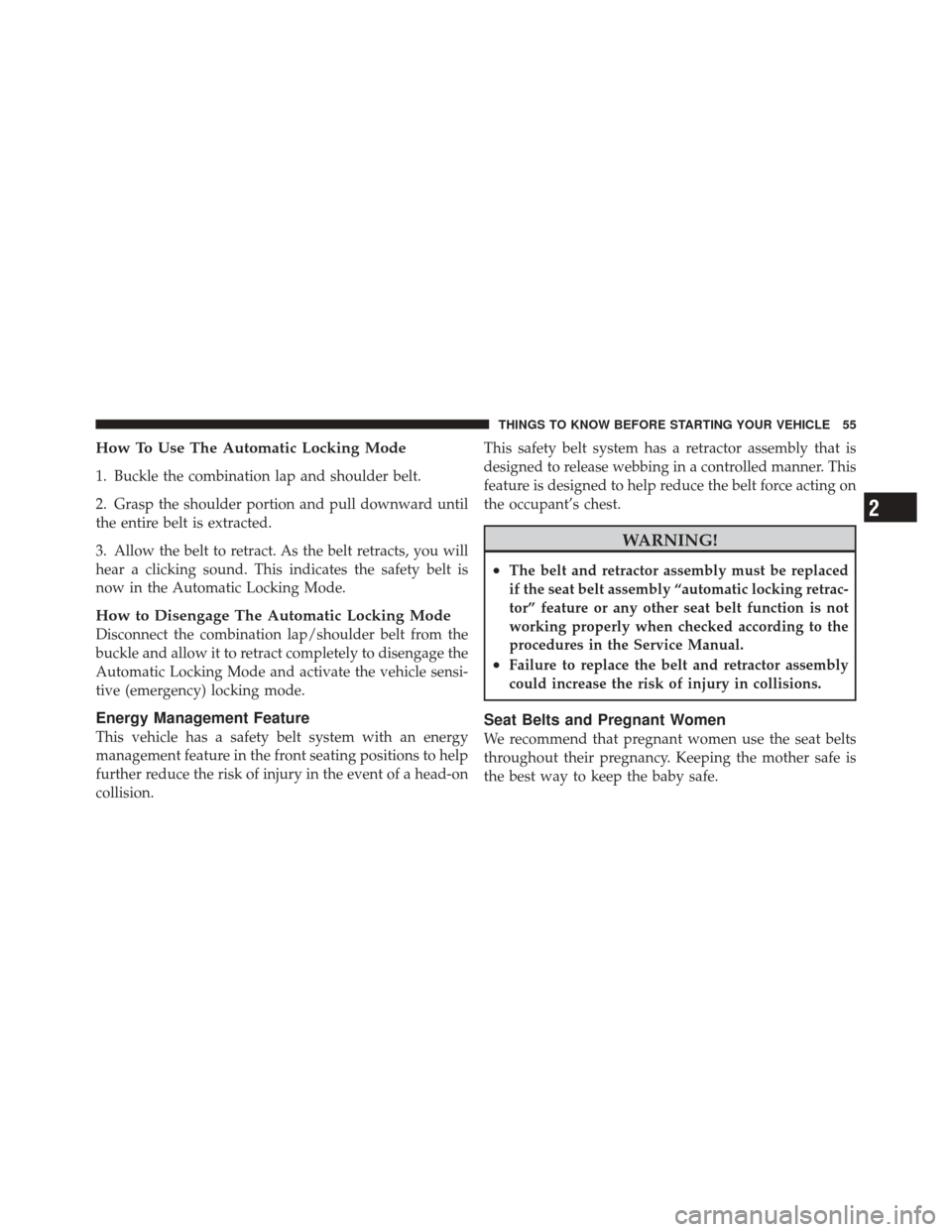
How To Use The Automatic Locking Mode
1. Buckle the combination lap and shoulder belt.
2. Grasp the shoulder portion and pull downward until
the entire belt is extracted.
3. Allow the belt to retract. As the belt retracts, you will
hear a clicking sound. This indicates the safety belt is
now in the Automatic Locking Mode.
How to Disengage The Automatic Locking Mode
Disconnect the combination lap/shoulder belt from the
buckle and allow it to retract completely to disengage the
Automatic Locking Mode and activate the vehicle sensi-
tive (emergency) locking mode.
Energy Management Feature
This vehicle has a safety belt system with an energy
management feature in the front seating positions to help
further reduce the risk of injury in the event of a head-on
collision.This safety belt system has a retractor assembly that is
designed to release webbing in a controlled manner. This
feature is designed to help reduce the belt force acting on
the occupant’s chest.
WARNING!
•The belt and retractor assembly must be replaced
if the seat belt assembly “automatic locking retrac-
tor” feature or any other seat belt function is not
working properly when checked according to the
procedures in the Service Manual.
•Failure to replace the belt and retractor assembly
could increase the risk of injury in collisions.
Seat Belts and Pregnant Women
We recommend that pregnant women use the seat belts
throughout their pregnancy. Keeping the mother safe is
the best way to keep the baby safe.
2
THINGS TO KNOW BEFORE STARTING YOUR VEHICLE 55
Page 57 of 522
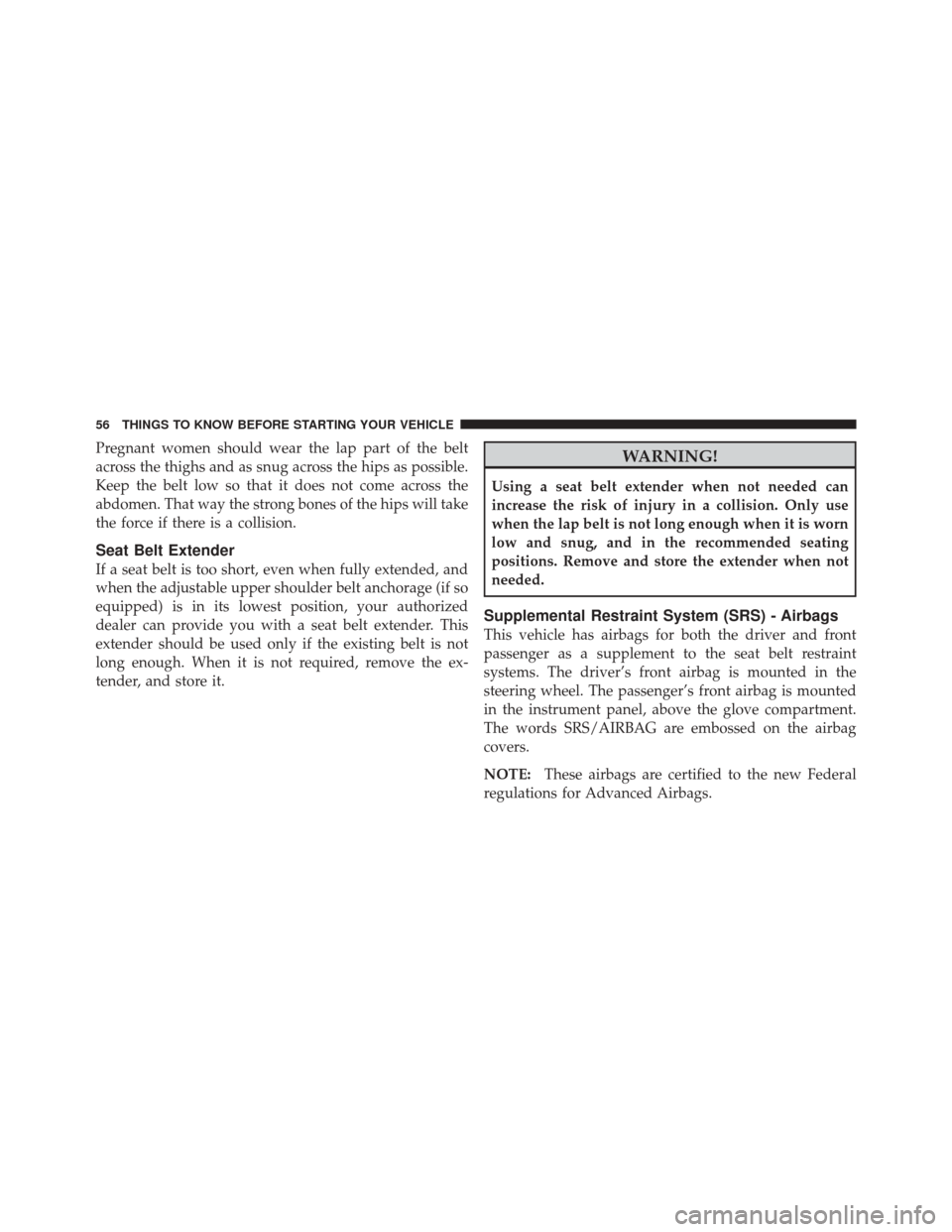
Pregnant women should wear the lap part of the belt
across the thighs and as snug across the hips as possible.
Keep the belt low so that it does not come across the
abdomen. That way the strong bones of the hips will take
the force if there is a collision.
Seat Belt Extender
If a seat belt is too short, even when fully extended, and
when the adjustable upper shoulder belt anchorage (if so
equipped) is in its lowest position, your authorized
dealer can provide you with a seat belt extender. This
extender should be used only if the existing belt is not
long enough. When it is not required, remove the ex-
tender, and store it.
WARNING!
Using a seat belt extender when not needed can
increase the risk of injury in a collision. Only use
when the lap belt is not long enough when it is worn
low and snug, and in the recommended seating
positions. Remove and store the extender when not
needed.
Supplemental Restraint System (SRS) - Airbags
This vehicle has airbags for both the driver and front
passenger as a supplement to the seat belt restraint
systems. The driver’s front airbag is mounted in the
steering wheel. The passenger’s front airbag is mounted
in the instrument panel, above the glove compartment.
The words SRS/AIRBAG are embossed on the airbag
covers.
NOTE:These airbags are certified to the new Federal
regulations for Advanced Airbags.
56 THINGS TO KNOW BEFORE STARTING YOUR VEHICLE
Page 59 of 522
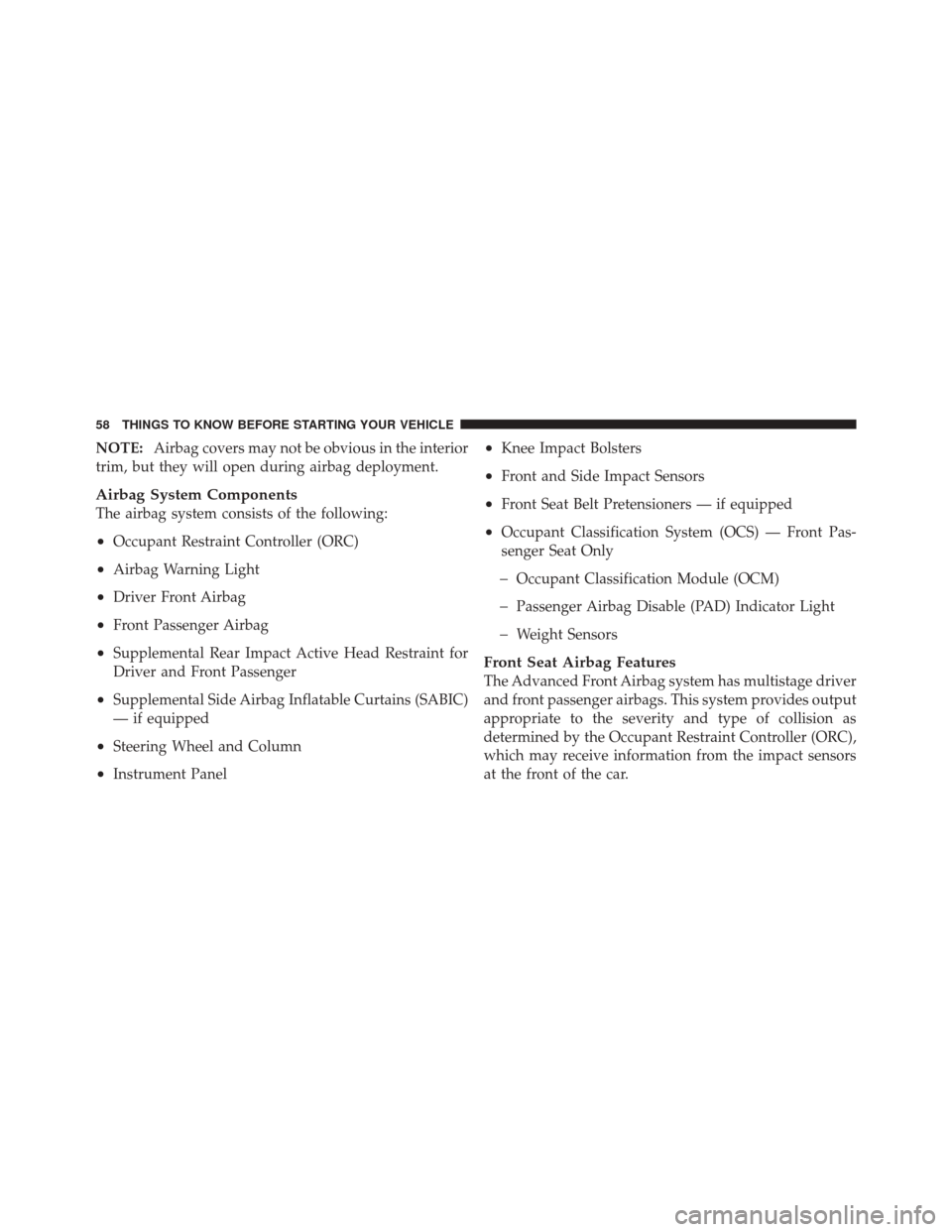
NOTE:Airbag covers may not be obvious in the interior
trim, but they will open during airbag deployment.
Airbag System Components
The airbag system consists of the following:
•Occupant Restraint Controller (ORC)
•Airbag Warning Light
•Driver Front Airbag
•Front Passenger Airbag
•Supplemental Rear Impact Active Head Restraint for
Driver and Front Passenger
•Supplemental Side Airbag Inflatable Curtains (SABIC)
— if equipped
•Steering Wheel and Column
•Instrument Panel
•Knee Impact Bolsters
•Front and Side Impact Sensors
•Front Seat Belt Pretensioners — if equipped
•Occupant Classification System (OCS) — Front Pas-
senger Seat Only
�Occupant Classification Module (OCM)
�Passenger Airbag Disable (PAD) Indicator Light
�Weight Sensors
Front Seat Airbag Features
The Advanced Front Airbag system has multistage driver
and front passenger airbags. This system provides output
appropriate to the severity and type of collision as
determined by the Occupant Restraint Controller (ORC),
which may receive information from the impact sensors
at the front of the car.
58 THINGS TO KNOW BEFORE STARTING YOUR VEHICLE